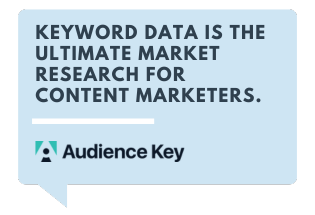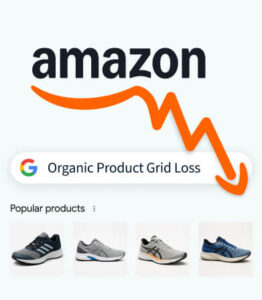How to Map Search Terms to Your Customer Journey
A few years ago, Google shared its findings from a six-month deep dive into their users’ clickstream data to understand customers’ journeys. They found that consumer touchpoints can range from 20 to 500, depending on what they are purchasing. In one example they shared, a consumer’s journey to buy a candy bar took 20 touchpoints, while another’s journey to book a flight took 500. The point: No two customer journeys are alike, and the path to purchase is far from linear … even for a candy bar.
How does an airline company build an omnichannel, full-funnel content marketing strategy that hits all 500 touchpoints? How does a candy maker create a content strategy to show up, front and center, for all 20 customer touchpoints?
… Perhaps we’re asking the wrong questions. Maybe we should be asking, “How can I build a database of intentions so I can respond to my audience’s needs, wherever they are in the journey?”
The Database of Intentions Concept
Back in 2003 — 20 years ago (!) — a fellow named John Battelle, co-founding editor of Wired magazine, connected with a couple of guys named Larry and Sergei in a Silicon Valley garage. In following the emerging journey of Google in its formative years, Battelle coined the term database of intentions to describe what Google’s archive of society’s search queries was evolving into. Battelle defined database of intentions as “a massive database of desires, needs, wants, and likes that can be discovered, subpoenaed, archived, tracked and exploited to all sorts of ends.”
Building a Database of Intentions for Your Addressable Audience
John Battelle’s concept is a powerful one for SEOs and content marketers. 20 years later, a usable form of Google’s search behavior data is readily available to us through a plethora of SEO research tools. By harnessing keyword search behavior data effectively, we have everything needed to construct a database of intentions for a particular audience or topic.

So now we can craft our own database of intentions for a business, exploiting keyword data to decipher the desires, needs, wants and likes of its addressable audience. Keyword data is the ultimate market research for content marketers.
Building a database of intentions is NOT simply building a keyword list. Building a database of intentions is compiling keywords into a database oriented structure, so that it can be sliced, diced, segmented, and analyzed in all kinds of ways. It’s augmenting keyword search volume with attribute tagging, associated SERP features, ranking data, intent, competitive difficulty, and so forth.
It is with this type of structure and data augmentation that allows keyword research to be exploited in the most beneficial ways for effective content marketing and SEO strategies.
Types of search queries
Building on the theory of a database of intentions, the content marketing industry has bucketed keywords into four types of search queries, based on user intent:
- Informational: I have a question and need an answer.
- Navigational: I am looking for a specific website, brand or page.
- Commercial: I want to learn more about a product or service.
- Transactional: I want to buy something.
There’s a pervasive misconception of how to effectively use intent-type attribution, which becomes crystal clear when time is taken to map your keywords to specific content pages. Instead of assigning those search-type qualities to keywords, assign them to pages. This user-focused content strategy builds a database of content that aligns with your audience’s intentions and gives much clearer guidance to content creators. Pages are informational, navigational, commercial or transactional.
User-focused strategy
A user-focused strategy is the foundation on which we built Audience Key: Create a platform where strategists can structure content to align with their audience’s needs (aka intentions), map keywords to those pages, and create content that aligns your messaging with user intent. This becomes a content strategy rooted in a database of intentions.
Good website architecture is designed around user intent. The site delivers pages to its audience based on their intentions. If a consumer is researching tire treads, for example, a tire seller delivers an informational article, video or guide about tire treads. If they’re looking to purchase tires for their vehicles, the tire seller will deliver product-specific information with product specs, reviews, pricing, etc.
The tire seller’s customer journey starts with awareness (how do i know if i need new tires, how long do tires last), followed by consideration and evaluation (what is the best tire for my honda crx), and then decision (deals on goodyear tires, goodyear tires cheap, where can i buy radial tires online or near me).
What Is Informational Intent?
Informational searches are intended for education, research, knowledge, or some other non-buying reason. Informational searches show low intent to purchase in the moment. The intent is to learn, not necessarily to purchase … yet. Here are examples of informational keyword searches for a tire seller:
- how does a tire gauge work
- what is the tire penny test
- how do i know if i need new tires
- why is my car making that sound
- how long do tires last
- what do the numbers on the side of a tire mean
- all season versus all weather
Informational content builds trust between your audience and your brand. Content created to answer non-transactional searches demonstrates your knowledge and authority. Even though a blog post is less likely than a product page to sell tires, the article will help build brand awareness and subject matter expertise between you and your audience. By having a large corpus of topic-related content it also aids as an additional authority signal to search engines.
What pages align best with informational searches? Blog posts and resource pages.
What Does Transactional Intent Suggest?
Transactional searches strongly suggest intent or desire to buy. Try any of the radial-tire searches in the below list, and note what Google (or Bing, Yahoo or your preferred search engine) serves you. Here are examples of buyer intent keyword searches:
- radial tires near me
- who sells radial tires
- how much are radial tires
- what kind of radial tires do i need
- radial tires for a honda crx
- goodyear wrangler versus falken wildpeak
Transactional content is designed to convert your visitors into customers, clients or buyers. It’s directly linked to your goods and/or services — conversion pages.
What pages align best with transactional searches? Product pages, category pages, and offer pages.
What About Navigational and Commercial Searches?
While informational content tends to serve your audience earlier in their customer journeys, and transactional pages tend to serve content down-funnel, when they’re ready to buy, your navigational and commercial content meets them in the middle.
Navigational search intent
To meet your audience mid-funnel when they’re comparing you with competitors, comparing products and services, and learning about your brand, serve them up with branded and location-focused content. What types of pages align with navigational searches? In addition to local search optimization, these pages can address navigational search intent. Here are examples of a navigational search query (using the fictional ABC Tire brand):
- where is abc tire, abc tire near me
- abc tire official site
- who owns abc tire
- how to contact abc tire
Commercial search intent
Commercial searches are closely related to transactional searches because they suggest a strong intent to buy. This content might consist of articles, guides, and resource pages that address:
- abc tire versus goodyear tire
- is abc tire any good
- who sells the best tires
- alternatives to abc tire
- abc tire competitors
Creating Content for Different Types of Search
In this post, we explored searcher intent: What does a searcher want when they enter queries into search fields, and how can we create content to meet those intentions?
The best SEO strategy begins with understanding audience intent — what does your audience want when they search for a keyword phrase? With a clear understanding of the intentions behind search terms, you can develop a robust database of intentions, comprised of URLs, mapped keywords and content that speaks to the user intent.
We built Audience Key based on these intention-based fundamentals of SEO. Instead of building a website based on keywords, Audience Key puts your users first. Build a taxonomy of pages that aligns with your users’ intentions, map the keywords to those pages, and then create content that aligns your business with your audience’s needs.
It’s that simple.
To see how Audience Key turns ordinary keyword strategy and mapping into an intention-based and data-driven strategy, sign up for a free trial.





